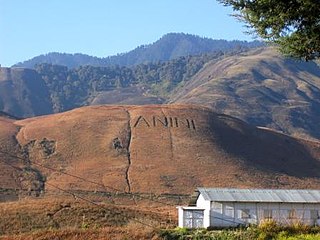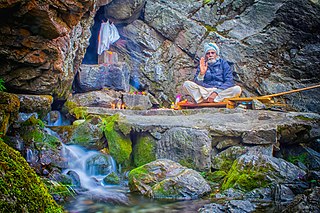
Arunachal Pradesh is a state in Northeastern India. It was formed from the erstwhile North-East Frontier Agency (NEFA) region, and became a state on 20 February 1987. It borders the states of Assam and Nagaland to the south. It shares international borders with Bhutan in the west, Myanmar in the east, and a disputed border with China in the north at the McMahon Line. Itanagar is the state capital of Arunachal Pradesh. Arunachal Pradesh is the largest of the Seven Sister States of Northeast India by area. Arunachal Pradesh shares a 1,129 km border with China's Tibet Autonomous Region.

The Mishmi or Deng people of Tibet and Arunachal Pradesh are an ethnic group comprising mainly three tribes: Idu Mishmi ; Digaro tribe, and Miju Mishmi. The Mishmis occupy the northeastern tip of the central Arunachal Pradesh in Upper and Lower Dibang Valley, Lohit and Anjaw Districts. The three sub-divisions of the tribe emerged due to the geographical distribution, but racially all the three groups are of the same stock. The Idu are also known as Yidu Lhoba in Tibet and often referred as Chulikatas in Assam. The Idus are primarily concentrated in the Upper Dibang Valley and Lower Dibang Valley district and parts of the northern part of Lohit district of Arunachal Pradesh in India. Taraon, also called Digaru Mishmis, are distributed in the hill and the foothills between the Dibang, Digaru and the Lohit rivers. Kamans are also known as the Miju Mishmis; they live between the Lohit and the Kambang rivers in the foothills and in the Mishmi Hills on both sides of the Lohit river right up to the frontiers to Rima. There are around 30,000 of them in Arunachal Pradesh.

Dibang Valley (Pron:/dɪˈbæŋ/) is a district of Arunachal Pradesh named after the Dibang River or the Talon as the Mishmis call it. It is the least populated district in India and has an area of 9,129 square kilometres (3,525 sq mi).

Lohit is an administrative district in the state of Arunachal Pradesh in India. The district headquarters is located at Tezu. As of 2011 it is the third most populous district of Arunachal Pradesh, after Papum Pare and Changlang.

Anini is the headquarters of the Dibang Valley district in the state of Arunachal Pradesh in Northeast India. Anini was also the district headquarters of the undivided Dibang Valley district. It is a small underdeveloped town, mainly because of its remoteness. Yet, it still has basic road and air links to the rest of India. The Idu Mishmi tribal people constitute a majority here. The town is fully dependent on the nearest major settlement, Roing, which is in the Lower Dibang Valley District, for most commercial needs.
Tezu is a census town and the headquarters of Lohit district in the Indian state of Arunachal Pradesh. It is the fifth largest town in Arunachal Pradesh and one of its most developed.

Walong is an administrative town and the headquarters of eponymous circle in the Anjaw district in eastern-most part of Arunachal Pradesh state in India. It also has a small cantonment of the Indian Army. Walong is on banks of Lohit River, which enters India 35 km north of Walong at India-China LAC at Kaho pass.

The Lohit River, also known as the Zayul Chu by the Tibetans and Tellu by the Mishmis, is a river in China and India, which joins the Brahmaputra River in the state of Assam. It is formed in the Zayul County of the Tibet Autonomous Region, through a merger of two rivers: the Kangri Karpo Chu, which originates in the Kangri Karpo range, and Zayul Chu, which originates to its northeast. The two rivers merge below the town of Rima. The combined river descends through this mountainous region and surges through Arunachal Pradesh in India for 200 kilometres (120 mi) before entering the plains of Assam where it is known as the Lohit River. Tempestuous and turbulent, and known as the river of blood partly attributable to the lateritic soil, it flows through the Mishmi Hills, to meet the Siang (Brahmaputra) at the head of the Brahmaputra valley.

In in Northeastern India, the Miju Mishmi, also known as Kaman or Kammaan, are one of the three tribes of the Mishmi people of Tibet and Arunachal Pradesh. Members of this tribe are located in Anjaw and Lohit districts. The Miju clans claim to have come from the Kachin country of Burma. They speak languages of the Midzu branch of Tibeto-Burman.

Roing is the district headquarter of Lower Dibang Valley district in the Indian state of Arunachal Pradesh. It is the last major township at the north-eastern frontier of India.
The Trans-Arunachal Highway (TAH), which includes an existing 1,811 km (1,125 mi) route comprising NH-13 and parts of NH-15, NH-215 and SH-25, is an under-construction 2-lane more than 2,407 km (1,496 mi) long highway passing through 16 districts in Arunachal Pradesh state in India. It runs from LAC in Tawang in northwest to Kanubari in southeast at tri-junction of Assam-Nagaland-Arunachal Pradesh. It connects at least 16 districts of Arunachal Pradesh.
Kaman, or Miju, is a small language of India and China. Long assumed to be a Sino-Tibetan language, it may be a language isolate.
Karikho Kri is a politician from Arunachal Pradesh state in India. He is a member of Arunachal Pradesh Assembly from Tezu in Lohit district. He comes from a tribe known as Mishmi.Tezu is a plain town with hills and a river surrounding it. He is an independent candidate and member of Arunachal Pradesh Legislative Assembly.

Parshuram Kund is a Hindu pilgrimage sites situated on the Brahmaputra plateau in the lower reaches of the Lohit River and 21 km north of Tezu in Lohit district of Arunachal Pradesh, India. Dedicated to sage Parshuram, the popular site attracts pilgrims from Nepal, from across India, and from nearby states of Manipur and Assam. Over 70,000 devotees and sadhus take a holy dip in its water each year on the occasion of Makar Sankranti, in the month of January.
Hayuliang is a town and the headquarters of an eponymous subdivision in the Anjaw district in the north-eastern state of Arunachal Pradesh, India. It is on the bank of the Lohit River near the confluence of the Delei River.

The Kamlang Wildlife Sanctuary, established in 1989, is the 50th Tiger reserve in India. The Sanctuary is rich with floral and faunal diversity. It is situated in the Lohit District of the northeastern Indian state of Arunachal Pradesh. The park is named after the Kamlang River which flows through it. The Mishmi, Digaro Mishmi, and Miju Mishmi people tribal people who reside around the periphery of the sanctuary claim their descent from the King Rukmo of the epic Mahabharata. They believe in a myth of an invisible god known as Suto Phenkhenynon jamalu. An important body of water in the sanctuary is the Glow Lake. Located in tropical and sub-tropical climatic zones, the sanctuary is the habitat of the four big cat species of India: tiger, leopard, clouded leopard and snow leopard.

Namsai district is an administrative district in the state of Arunachal Pradesh in north-east India.It was carved out of Lohit district in November 2014.
Lekang is a village and Tehsil in the Namsai district of Arunachal Pradesh state, India. According to the 2011 Census of India, it has 1,536 residents across 369 households. 828 are male and 708 are female.
Wakro is a village in Wakro circle of the Lohit district in Arunachal Pradesh state of India. The PIN code of Wakro is 792102. Wakro is connected by two national highways, National Highway 13 and National Highway 15











